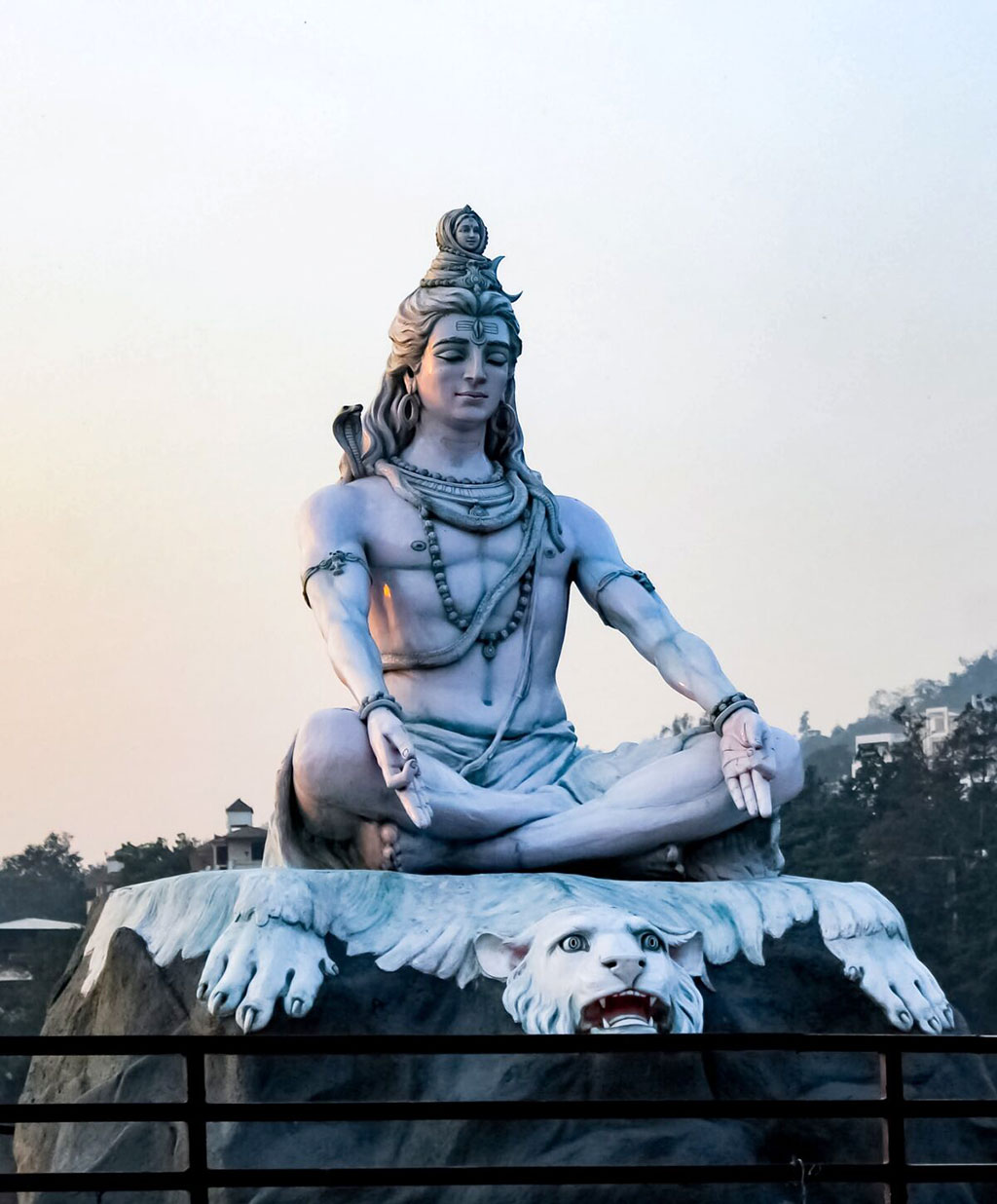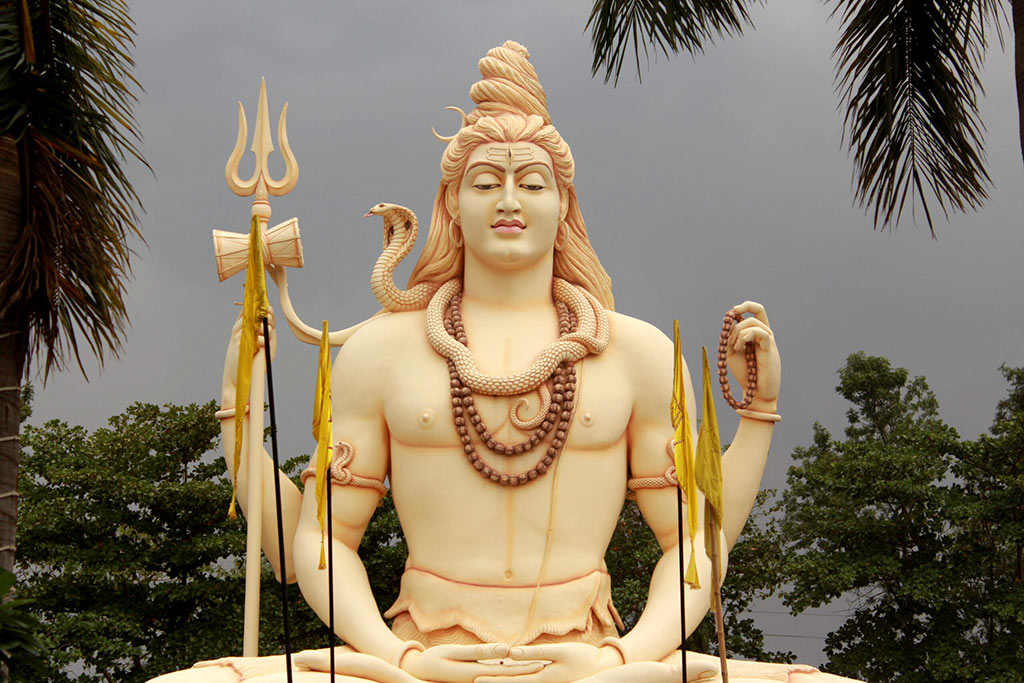
Lord Shiva, inspiring, mysterious, even foreboding. The ascetic immersed in Samadhi. The wild lord of the dance. Mahadeva, the greatest of Gods. Bhairava the terrifying nakedness of reality. Rudra, ‘the howler’, the fierce and dynamic aspect of motion of energy.
Shiva has many names, many aliases, appears in many different ways according to various traditions and texts.
But who is this mysterious, multi faceted, God?
Pre-Vedic Origins of Lord Shiva
It is possible that the origins of shiva in the Hindu pantheon, lay in a pre-Vedic tradition. The indus valley in modern day pakistan/afghanistan and northern Northern india was home to the Harappan civilisation. These people worshipped a deity known as Rudra. Rudra was a wrathful storm God and not considered a major deity. Later, Rudra took the nickname Shiva meaning ‘kind’ or ‘the auspicious one’.

Shiva in the Vedic Religion
Shiva was not a well known or popular deity in the Vedic period. He is very loosely referred to in Rig Veda, only in his form as Rudra. Here Rudra appears only in his negative aspects as a deity of sickness, disease, death and disaster.
Throughout the Vedic period variations on the theme of Rudra appear. Towards the end of this period he appears to have gained popularity. This we can assume because Atharvaveda makes considerably more mention of Rudra than does Rig Veda.
In Yajurveda and in Atharvaveda we see Shiva called by many names. Yet he is still evoked as Rudra and implored to alleviate the damage caused by natural disaster. As such, suggesting a growing popularity. However, in some hymns the names used to refer to Shiva actually refer to different gods. Which suggests some ambiguity over his identity. And, at the same time, a bringing together of multiple deities into a single identity.
Subsequently, the popularity of and love for Rudra as Shiva blossomed. He became more commonly known as Shiva. Eventually, Rudra became known as one of the 7 main hypostasis of Shiva.

The deity Shiva, in various forms entered into various traditions. The Puranas feature Lord Shiva as the third of three primary deities that describe the arising and passing of all phenomena.
In this vision Brahma, the creator, beats his drum, the rhythm of creation. Vishnu, playing his flute sustains the activities of cause and effect. Shiva, governs the dissolution of activity and the reabsorption of the related energies into their source. The pure consciousness of which all forms are merely expressions.
In this vision, Brahman or Parabrahman is the supreme or final, ultimate essence of reality. Brahma, Vishnu and Shiva, are more like functions of that essence.
Out of this trinity, referred to as the Trimurti, developed 2 major traditions, now two of the main traditions that fall under the loose umbrella of ‘Hinduism’. These are Shaivism, followers of Shiva that see Shiva as the essence of reality. And Vaishnavism, followers of Vishnu that see Vishnu as the essence of reality. For reasons unknown, Brahma never developed a strong following and there is no Brahmaism.
SHIVA IN TANTRA
Subsequently, with the birth of tantra, Shiva featured in a number of dualistic and non-dualistic traditions. Variously representing the fundamental essence of reality, or consciousness and its specific functions, or acts. In the non-dual traditions, shiva as pure consciousness is not separate or distinct from the power of consciousness. The power to manifest as the reality we appear to live in.
Thus, Shiva possesses fundamental powers. Firstly, to create the world by choosing to become ignorant of his own essence. Then to appear as these many forms. Lastly, the power of grace, the capacity to dissolve the many forms of appearance back into themselves, revealing their essence.
SHIVA IN THE PURANAS
The unmanifest, universal consciousness desired to manifest as the universe. Brahma the creator represents that impulse.
The intrinsic desire of consciousness to rest blissfully in its own nature, is Shiva.
Brahma is the tendency for thoughts, actions etc. to spring out of nowhere. In contrast, Shiva is the tendency of those thoughts, actions, emotions etc. to eventually dissolve back into themselves. Or, back into the silence from which they came.
As activity dissolves, the actor ceases focusing outwardly, upon things. Thus, attention ‘falls’ back into itself. This is the dance between Brahma (desire) and Shiva (dissolution).
This dance is described like so:
Brahma, the creator, desired to express and manifest the form of the universe. Shiva did not want this. So, he wanted to kill Brahma with an arrow. He shot at Brahma but was just a moment too late. The cycle of desire had already began, and Shiva was powerless to stop it.
The pulsation of that event still resonates in our consciousness as the primordial energy from which all impulse arise. Therefore, by continually feeding the desire towards things, rather than towards self awareness, we are creating the cycle of samsara.
Since Shiva was unable to kill Brahma, Shivas fierce form, Rudra, manifested as Agni, the god of fire, to protect samsara. Because of Agni there is motion, movement and Entropy.
Eventually agni consumes all. Thus, all merges back into its source of blissful, non-dual awareness.

ADI YOGI – LORD SHIVA AS THE FOUNDER OF YOGA
As the essence of reality Shiva is pure unmanifest potential. However, as mentioned, that potential manifests itself in a number of what could be called ‘pure’ or transparent forms. These forms express a particular divine attribute. Thus it is possible for the limited human being to acknowledge, worship and come close to that divine reality.
As mentioned, Shiva’s has many functions. One, for which he is sometimes known as the ‘destroyer’, is the capacity of revelation or dissolution. The means by which form is dissolved into the formless, ignorance is dissolved into the wisdom of self awareness.
Essentially, this is the innate knowledge within each being that leads us home. That leads us back to our essential Self, Shiva. This is called grace, or Anugraha. Out of this loving will to guide being home, Shiva manifested himself in the world as Adi Yogi. The First Yogi.
Adi Yogi is known as the preceptor of yoga, its first teacher and it’s creator. Essentially, yoga here means skillful means or method. Through these methods, human beings can become liberated from the bondage of belief that the egoic identity is who they actually are.
Seated high in the Hamalaya, Adi Yogi remains immobile in meditation for many months and years at a time. This form of Shiva eventually taught the methods of yoga to the Saptarishi.
SHIVA NATARAJA
The Lord of the cosmic dance. This form of Shiva is extremely subtle. Here Shiva appears as a cosmic dancer, dancing on the body a demon (the ego) in a large ring of fire.
This manifestation of Shiva expresses the divine pulsation of the universe. In the same way that science now understands that there is no such thing as matter, that what we call matter is merely vibration. Pulsation of subatomic particles in and out of existence so quickly that they have the appearance of form.
Think of lightbulbs that run on AC electrical sources. Essentially these are strobe lights, but they flash so fast that we don’t register the off moments, and we interpret them as emitting a consistent source of light.
In this way, Shiva as Nataraja, creates the appearance of solid existence, through the infinitely subtle vibration or pulsation of life force (Spanda). This might seem tricky and deceptive, but it too is indeed a form of grace. Essentially Shiva Nataraja tells us that every moment of perception can be the means of our bondage, or our liberation. It depends on how we approach our lives.
This is a fundamental understanding that underlies the entire tantric path to liberation. The world, or appearance, is not as it seems. This does not make it bad, wrong, or even problematic. In fact it makes it even more special, sacred, beautiful as rich, fertile ground for living Sadhana (spiritual practice).
LORD SHIVA AS PURE CONSCIOUSNESS
Perhaps most importantly of all, Shiva has become synonymous with consciousness itself. Or God. In earlier traditions, Brahman was the term used to the ‘absolute’ reality, or the ‘one without a second’. The principle of pure, formless unmanifest consciousness.
We can see this clearly in Nirvana Shatkam, one of the most important hymns of the classical tradition of Advaita Vedanta, attributed to its most important proponent, Adi Shankaracharya.
“I am consciousness and pure bliss without form,
I am Shiva, I am shiva”
Here Shiva is clearly equated with both the fundamental essence of the individual and the essential formless nature of reality itself, consciousness.
CONCLUSION
Shiva, Mahadeva, the greatest of all the Gods. Known by so many names, performing so many roles. Thus, it is not hard to see how Lord Shiva has become the most revered of all of the thousands, maybe millions of Hindu Deities.
Importantly, with a form and function to fit the temperaments of every seeker, regardless of how apparently contradictory they may seem. That is why Shiva remains an inspiration to spiritual practitioners from all corners of the world.